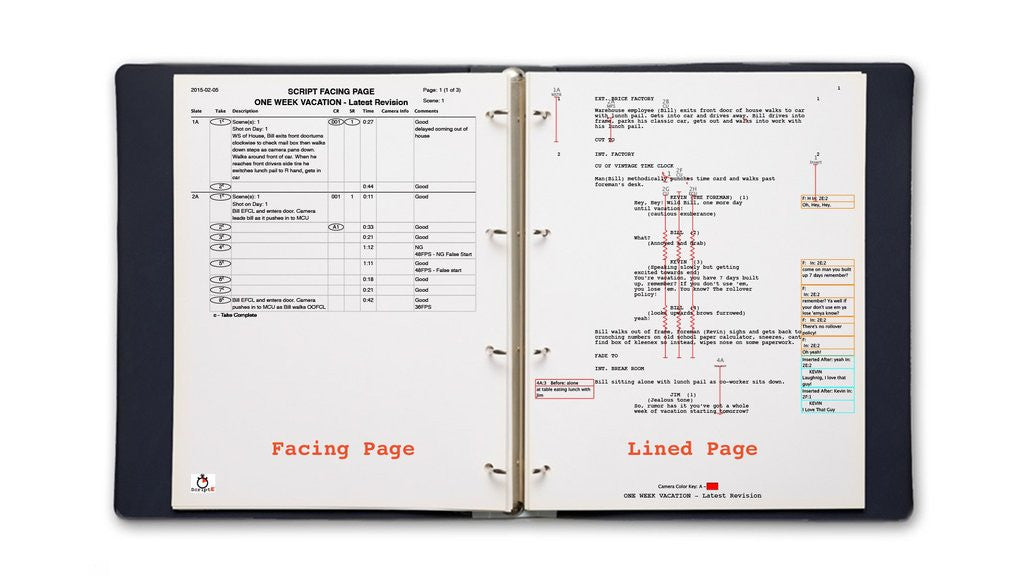
How do I read a lined script?
One regularly asked question on EditStock is "How do I read a lined script?" First you've got know what a lined script is.
A lined script is a document created by the script supervisor during production. The script supervisor sits next to the director on set and acts like the eyes and ears of the editor.
On the creative front, the script supervisor takes detailed notes on what the directors says are the best performances (called circle takes). The script supervisor also takes notes when the dialog was improvised and therefore different than the script, keeps track of actor continuity, and keeps track of dozens of other details like what wardrobe the actors were wearing.
On the technical front, the script supervisor keeps track of what camera roll the camera department is on, what sound roll the sound production is on. The script supervisor is an assistant editor's best friend.
Facing vs Lined Pages
A lined script is made up of two types of pages: lined, and facing.
The lined pages are probably what you think of when someone refers to a lined script. These pages look like the script except that they have a bunch of squiggly lines drawn through the text.
The lined pages give you an idea of what the coverage (different camera angles) looks like for any given moment of the scene.
The facing pages are the pages that are placed on the left side of the editors binder. The facing pages give you technical understanding of the filmmaking.

How the Editor Gets the Pages
Every day when production wraps someone from production will bring the days lined pages over to the post production department. The assistant editors will then put those pages away into the lined script binder.
It's important to note that reality shows and documentaries do not get lined scripts. Only projects that start with a script get a lined script. Most indie projects do not create lined scripts because of the cost hiring a script supervisor, but lined scripts more important as your productions get more and more complicated. Every high end project will have a script supervisor though.
Let's dig into a couple pages of a lined script from the film Anesthesia EDU:
Lined Page
On this page we see straight lines and squiggly lines. The straight line means that you CAN see the actor's face in that camera angle. The squiggle means you CANNOT see the actor's face. Let's take a look at shot 3A-3 from Anesthesia
Now take a look at what the lined script says about this shot. We can see that Dr. Clayton had the squiggly line and we didn't see his face.

We can also tell where a shot starts and stops. If you look at the bottom of Mary's line "You could say that" you'll see a line indicating that this is where shot 3A ends. However, shots 4B, 4C, and 4D continue on to the next page because they have an arrow pointing down.
Facing Page
The facing page is like a cheat sheet of what coverage was shot for that scene. For example with shot 3A I know I have three takes. Notice that takes two and three are circled. These "circle takes" are the ones the director likes the most. That doesn't mean we don't look at take one. We just know that the director liked takes two and three better.

The facing page also tells me that the RED file for shot 3A is on camera roll A2. As an assistant editor this saves you tons of time tracking things down.
Be Brave and Go Forth!
Years ago I was working as an assistant editor on my first film. I spotted the word SER in the editor's lined script and wrote myself a note to look it up what SER meant. The next day I was very embarrassed when the editor came in, saw the note, and explained to me that SER means the take is a series of shots but without any cuts, and so not technically take two or three. That editor, who I consider a friend to this day, told me that there was nothing to be embarrassed about. My advice to you is the same. Ask questions! Lined scripts have tons of short hand like NG, GT, MOS, SER, and the list goes on (that's an article for another day). There is no way to learn without asking.
View all of our projects in the Edit Shop.









15 comments
PLEASE don’t call us “Scripty.” It’s a cutesy name that takes us back to the days of “script girls.” We are Script Supervisors or Continuity. We are dept heads and are needing respect for our jobs so we can get our wages up to those male dept heads. Please help us out and stop using “Scripty” for Script Supervisor.
As a script supervisor, I appreciate many things about this article. However, please note that many script supervisors are insulted by the term “scripty” as it is demeaning to the difficult and important department head position. I encourage everyone to listen to the podcast, “Script Supervisors: Unsung Heroes of Film &TV” wherever you get your podcasts for more information about this misunderstood and amazing craft!!
Many script supervisors consider scripty a derogatory term. If you want our interest, you should rewrite the article with the proper term.
@Khari, BSF probably should read B-SF (B-camera, Single Full Shot)…
For those struggling to find out what the abreviations mean, search for “Production Paperwork Abbreviations Guide” and you will find a guide explaining all of them. Funnily enough, it is actually on this site, so here’s a direct link: “https://help.editmentor.com/en/articles/5379631-production-paperwork-abbreviations-guide”.